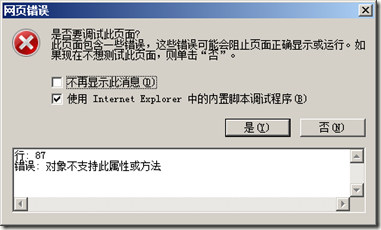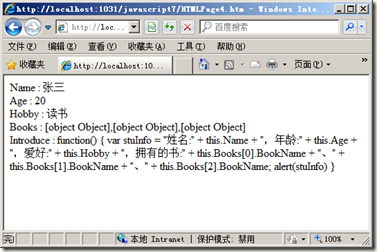javascript 面向对象编程 聊聊对象的事_js面向对象
先看一下JSON(javascript object notation)对象,JSON是一种脚本操作时常用的数据交换格式对象,相对于XML来说JSON是一种比较轻量级的格式,在一些intelligence的IDE中还可以方便的通过点操作JSON对象中的成员。
JSON是一种键/值对方式来描述内部成员的格式,其内部成员可以是几乎任何一种类型的对象,当然也可以是方法、类、数组,也可以是另外一个JSON对象。
<SPAN class=kwrd>var</SPAN> student = {Name: <SPAN class=str>"张三"</SPAN>,
Age: 20,
Hobby: <SPAN class=str>"读书"</SPAN>,
Books: [
{BookName : <SPAN class=str>"C#"</SPAN> ,
Price : 70
},
{BookName : <SPAN class=str>"Java"</SPAN> ,
Price : 70
},
{BookName : <SPAN class=str>"Javascript"</SPAN> ,
Price : 80
}
]
};
上面代码用JSON对象描述了一个学生的信息,他有姓名、年龄、爱好、书集等。在访问该学生对象时,可以通过student变量来操作学生的信息。
<SPAN class=kwrd>var</SPAN> stuInfo = <SPAN class=str>"姓名:"</SPAN> + student.Name +
<SPAN class=str>",年龄:"</SPAN> + student.Age +
<SPAN class=str> ",爱好:"</SPAN> + student.Hobby +
<SPAN class=str>",拥有的书:"</SPAN> +
student.Books[0].BookName + <SPAN class=str>"、"</SPAN> +
student.Books[1].BookName + <SPAN class=str>"、"</SPAN> +
student.Books[2].BookName;
alert(stuInfo);
这样的操作方式风格和C#也非常相像。以上的代码是静态的构造出了学生对象,学生对象的结构就确定了。在其它的编程语言中一般对象结构一旦确定就不能很方便的进行修改,但是在javascript中的对象结构也可以方便的进行改动。下面为student对象添加一个Introduce方法来做自我介绍。
student.Introduce = <SPAN class=kwrd>function</SPAN>() {<SPAN class=kwrd>var</SPAN> stuInfo = <SPAN class=str>"姓名:"</SPAN> + <SPAN class=kwrd>this</SPAN>.Name +
<SPAN class=str>",年龄:"</SPAN> + <SPAN class=kwrd>this</SPAN>.Age +
<SPAN class=str>",爱好:"</SPAN> + <SPAN class=kwrd>this</SPAN>.Hobby +
<SPAN class=str>",拥有的书:"</SPAN> +
<SPAN class=kwrd>this</SPAN>.Books[0].BookName + <SPAN class=str>"、"</SPAN> +
<SPAN class=kwrd>this</SPAN>.Books[1].BookName + <SPAN class=str>"、"</SPAN> +
<SPAN class=kwrd>this</SPAN>.Books[2].BookName;
alert(stuInfo)
};
student.Introduce();
student对象原来并没有Introduce方法,第一次为student.Introduce赋值会在student对象中创建一个新的成员,后面如果再为student.Introduce赋值则会覆盖上一次所赋的值。当然我们这的值是一个function。也可以用类似索引的方式来添加成员。
student[<SPAN class=str>"Introduce"</SPAN>] = <SPAN class=kwrd>function</SPAN>() {……
};
student.Introduce();
当然添加的成员也可以删除掉。删除掉之后则成为undefined,再访问该成员时则不支持。
delete student.Introduce;
student.Introduce();
javascript是弱类型的语言,有的时候即使有IDE的辅助也不能很清楚知道当前所操作对象的成员,可能会需要对当前对象的属性进行查询,这时候我们可以使用for循环来完成。
<SPAN class=kwrd>for</SPAN> (<SPAN class=kwrd>var</SPAN> key <SPAN class=kwrd>in</SPAN> student) {document.write(key + <SPAN class=str>" : "</SPAN> + student[key] + <SPAN class=str>"<br />"</SPAN>);
};
对student对象进行遍历时,是对student的成员进行遍历,这里的key则对应student对象中的每一个成员属性名称。student[key]则是对student某个成员进行访问。如果想调用student的Introduce方法也可以用索引的方式,student[“Introduce”]()。
上面简单的聊了聊JSON对象,总的来说JSON是很方便的数据打包方式。javascript中的其它的对象,不论是浏览器对象,还是自定义类型所创建的对象或者是数组等等,它们也都具有JSON对象类似的操作方式。我们可以直接用索引的方式为window添加成员,我们也可以为数组添加字符串形式的下标把它当成Hashtable来操作。
window[<SPAN class=str>"Hi"</SPAN>] = <SPAN class=kwrd>function</SPAN>() {alert(<SPAN class=str>"helloworld!"</SPAN>);
};
window[<SPAN class=str>"Hi"</SPAN>]();
<SPAN class=kwrd>var</SPAN> array = [];
array[<SPAN class=str>"一"</SPAN>] = <SPAN class=str>"A"</SPAN>;
array[<SPAN class=str>"二"</SPAN>] = <SPAN class=str>"B"</SPAN>;
array[<SPAN class=str>"三"</SPAN>] = <SPAN class=str>"C"</SPAN>;
array[<SPAN class=str>"四"</SPAN>] = <SPAN class=str>"D"</SPAN>;
alert(array[<SPAN class=str>"一"</SPAN>] + array[<SPAN class=str>"二"</SPAN>] + array[<SPAN class=str>"三"</SPAN>] + array[<SPAN class=str>"四"</SPAN>]);
把数组当成Hashtable来操作时,要注意,并非是为数组添加数组元素,而是在数组对象中添加新的属性成员。而且如果for(var key in array)循环遍历数组对象的话,key得到的却不是array对象的属性名称,而是数组元素的索引号。
下一次聊聊function。

Hot AI Tools

Undresser.AI Undress
AI-powered app for creating realistic nude photos

AI Clothes Remover
Online AI tool for removing clothes from photos.

Undress AI Tool
Undress images for free

Clothoff.io
AI clothes remover

Video Face Swap
Swap faces in any video effortlessly with our completely free AI face swap tool!

Hot Article

Hot Tools

Notepad++7.3.1
Easy-to-use and free code editor

SublimeText3 Chinese version
Chinese version, very easy to use

Zend Studio 13.0.1
Powerful PHP integrated development environment

Dreamweaver CS6
Visual web development tools

SublimeText3 Mac version
God-level code editing software (SublimeText3)

Hot Topics
 1664
1664
 14
14
 1423
1423
 52
52
 1317
1317
 25
25
 1268
1268
 29
29
 1248
1248
 24
24
 How to implement object-oriented event-driven programming using Go language
Jul 20, 2023 pm 10:36 PM
How to implement object-oriented event-driven programming using Go language
Jul 20, 2023 pm 10:36 PM
How to use Go language to implement object-oriented event-driven programming Introduction: The object-oriented programming paradigm is widely used in software development, and event-driven programming is a common programming model that realizes the program flow through the triggering and processing of events. control. This article will introduce how to implement object-oriented event-driven programming using Go language and provide code examples. 1. The concept of event-driven programming Event-driven programming is a programming model based on events and messages, which transfers the flow control of the program to the triggering and processing of events. in event driven
 What is the importance of @JsonIdentityInfo annotation using Jackson in Java?
Sep 23, 2023 am 09:37 AM
What is the importance of @JsonIdentityInfo annotation using Jackson in Java?
Sep 23, 2023 am 09:37 AM
The @JsonIdentityInfo annotation is used when an object has a parent-child relationship in the Jackson library. The @JsonIdentityInfo annotation is used to indicate object identity during serialization and deserialization. ObjectIdGenerators.PropertyGenerator is an abstract placeholder class used to represent situations where the object identifier to be used comes from a POJO property. Syntax@Target(value={ANNOTATION_TYPE,TYPE,FIELD,METHOD,PARAMETER})@Retention(value=RUNTIME)public
 PHP Advanced Features: Best Practices in Object-Oriented Programming
Jun 05, 2024 pm 09:39 PM
PHP Advanced Features: Best Practices in Object-Oriented Programming
Jun 05, 2024 pm 09:39 PM
OOP best practices in PHP include naming conventions, interfaces and abstract classes, inheritance and polymorphism, and dependency injection. Practical cases include: using warehouse mode to manage data and using strategy mode to implement sorting.
 Explore object-oriented programming in Go
Apr 04, 2024 am 10:39 AM
Explore object-oriented programming in Go
Apr 04, 2024 am 10:39 AM
Go language supports object-oriented programming through type definition and method association. It does not support traditional inheritance, but is implemented through composition. Interfaces provide consistency between types and allow abstract methods to be defined. Practical cases show how to use OOP to manage customer information, including creating, obtaining, updating and deleting customer operations.
 Are there any class-like object-oriented features in Golang?
Mar 19, 2024 pm 02:51 PM
Are there any class-like object-oriented features in Golang?
Mar 19, 2024 pm 02:51 PM
There is no concept of a class in the traditional sense in Golang (Go language), but it provides a data type called a structure, through which object-oriented features similar to classes can be achieved. In this article, we'll explain how to use structures to implement object-oriented features and provide concrete code examples. Definition and use of structures First, let's take a look at the definition and use of structures. In Golang, structures can be defined through the type keyword and then used where needed. Structures can contain attributes
 Analyzing the Flyweight Pattern in PHP Object-Oriented Programming
Aug 14, 2023 pm 05:25 PM
Analyzing the Flyweight Pattern in PHP Object-Oriented Programming
Aug 14, 2023 pm 05:25 PM
Analyzing the Flyweight Pattern in PHP Object-Oriented Programming In object-oriented programming, design pattern is a commonly used software design method, which can improve the readability, maintainability and scalability of the code. Flyweight pattern is one of the design patterns that reduces memory overhead by sharing objects. This article will explore how to use flyweight mode in PHP to improve program performance. What is flyweight mode? Flyweight pattern is a structural design pattern whose purpose is to share the same object between different objects.
 Analysis of object-oriented features of Go language
Apr 04, 2024 am 11:18 AM
Analysis of object-oriented features of Go language
Apr 04, 2024 am 11:18 AM
The Go language supports object-oriented programming, defining objects through structs, defining methods using pointer receivers, and implementing polymorphism through interfaces. The object-oriented features provide code reuse, maintainability and encapsulation in the Go language, but there are also limitations such as the lack of traditional concepts of classes and inheritance and method signature casts.
 In-depth understanding of PHP object-oriented programming: Debugging techniques for object-oriented programming
Jun 05, 2024 pm 08:50 PM
In-depth understanding of PHP object-oriented programming: Debugging techniques for object-oriented programming
Jun 05, 2024 pm 08:50 PM
By mastering tracking object status, setting breakpoints, tracking exceptions and utilizing the xdebug extension, you can effectively debug PHP object-oriented programming code. 1. Track object status: Use var_dump() and print_r() to view object attributes and method values. 2. Set a breakpoint: Set a breakpoint in the development environment, and the debugger will pause when execution reaches the breakpoint, making it easier to check the object status. 3. Trace exceptions: Use try-catch blocks and getTraceAsString() to get the stack trace and message when the exception occurs. 4. Use the debugger: The xdebug_var_dump() function can inspect the contents of variables during code execution.






